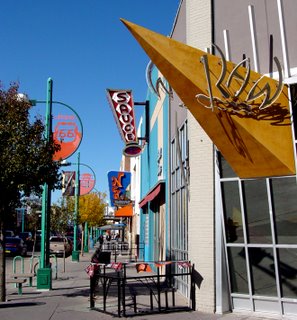PREVIEW
Kitty Carlisle Hart: "Here's to Life"
With pianist David Lewis. 8 tonight. 5 p.m. Sunday. $35-$100. 14th Street Playhouse, 173 14th St. N.E., Midtown. 404-733-5000, woodruffcenter.org.
The weather called for heavy flooding with a slight chance of pneumonia, followed by a cold blast. But Kitty Carlisle Hart —- the Manhattan social butterfly, arts advocate, quiz-show pioneer, Metropolitan Opera diva, Marx Brothers co-star and famous playwright's widow —- was not about to wilt.
Tuesday night, it was caviar at Restaurant Eugene in Buckhead. Wednesday morning, she braved the rain in pearls and a dazzling peach suit for a round of interviews —- with a two-hour lunch sandwiched in between. And Thursday night, "at the mere age of 96," she gave the first of four Atlanta performances —- getting a standing ovation before she could warble a note from her Broadway songbook or reveal a single tidbit about her illustrious circle of dearly departed friends: George Gershwin, Cole Porter, Jerome Kern, Bing Crosby, Richard Rodgers and numerous others.
While her own career may have been relatively minor, Hart was intimately acquainted with most of the leading lights of American musical theater.
If you are under 40, you may have no idea who Kitty Carlisle Hart is. But if you grew up in the '50s, '60s and '70s, you will remember her as the ever-curious panelist on TV's "To Tell the Truth," an early game show featuring a roster of wits who looked as if they were dressed for a night of dancing at El Morocco.
As America became a place of ranch houses, station wagons and backyard barbecues, this New York smart set was the last vestige of a vanishing, glamorous age. Appearing with the likes of Johnny Carson, Dick Van Dyke and Peggy Cass, Hart was celebrated for her effervescent wit, endless wardrobe and million-dollar smile. "TV's touch of class," as a quip from the video montage that introduces her show puts it.
Though the former Ziegfeld Follies dancer looks a little frail when she arrives Tuesday at WAGA-TV, everything changes the minute she perches on the recording studio couch.
"Now you have been on TV before," her producer, Joe Spotts, says, arranging a dais of pillows for her to sit on. "You know what to do." Sure enough, as the cameras roll, Hart's rouged cheeks glow, her lips put on a smile to make Carol Channing envious, and the so-called "oldest gal in showbiz" is suddenly on —- tossing off bons mots about the glittering diamond necklace she wears during her performances.
"My mother told me she got it from the king of Bulgaria," Hart says, "and I believed it for 40 years. What nonsense!"
"Kitty is just Kitty all the time," Spotts says later. "Camera-ready, every minute."
But life hasn't always been a parade for Hart, who lives in a Park Avenue apartment decorated with paintings by friends like Noel Coward, Marc Chagall and Harpo Marx, and is known to greet visitors wearing a bright-red kimono.
Born Catherine Conn in New Orleans in 1910, Hart lost her physician father when she was 10; he died in the typhoid epidemic. Soon, her ambitious, social-climbing mother pushed her onto the stage. She led a swank life as the wife of theater luminary Moss Hart, but the playwright died of a heart attack in 1961, leaving her to raise their two children alone.
Along the way, this granddaughter of a Confederate soldier who survived the battle of the Monitor and the Merrimack has battled anti-Semitism —- from her own mother, even. And as chairman of the New York State Arts Council from 1976-1996, she had to defend controversial exhibits by Robert Mapplethorpe and Andres Serrano. Spotts rescued her from performing on the cruise-ship circuit.
"My mother wanted me to marry a rich nobleman —- and failing that, an impoverished baron," Hart says, nibbling a lunch of salad, soup, ginger ale and just a few bites of creme brulee at Buckhead's Bones. Though her European education never made her a princess, she ended up courting theater royalty —- demurring a proposal from Gershwin but accepting one from Hart after a 10-year courtship.
As she talks, Hart chuckles heartily and throws her hands in the air to emphasize a remark. Her mother always wanted them to pass for Gentiles, Hart says. (Once, when a taxi driver asked if her daughter was Jewish, her mother replied: "She may be, but I'm not!") She changed her name to Kitty while attending school in Switzerland; she found the name Carlisle in the Manhattan telephone directory.
During her concert, Hart leans on the piano and only occasionally forgets a lyric. Her voice is weathered, but she looks remarkably fit.
Sprinkling the night with anecdotes from the golden age of Broadway and TV, she recalls once being scolded by composer Kern for changing key during "Smoke Gets in Your Eyes." She remembers crooner Crosby having to stand on a platform during filming of a duet in 1934's "She Loves Me Not" to reach her height. She lifts her skirt to reveal the legs that made her performance in vaudeville impresario Flo Ziegfeld's late-1920s "Rio Rita" so memorable, and she recalls Gershwin as a man who "needed constant approval.
"Women adored him, and he returned the compliment —- I should know," she says with a wink.
After Carlisle made the Marx Brothers' "A Night at the Opera" with screenwriter George S. Kaufman in 1935, he introduced her to two Broadway scribes who were in Hollywood shopping for actresses. The pair turned out to be Cole Porter and Moss Hart, and their musical was "Jubilee" ("It Was Just One of Those Things").
"I didn't get the job , but many years later, I got the man," Hart tells her audience. Before the marriage, Kaufman and Hart wrote two of the most successful comedies of their time: "You Can't Take It With You," which won the Pulitzer Prize of 1937, and "The Man Who Came to Dinner."
These days, Hart says she feels like Dickens' Miss Havisham in her enormous New York apartment.
"It's half a city block, and it was just fine when I had two children and two servants. ... However, I'm not going to move, because that kills people. I'm going to be taken out feet first."
(By the way, gentlemen, if you are thinking of asking Hart out, get in line. She has plenty of beaus already. "I have one who is 103, sharp as a tack. ... And I have one who is younger than I am. He's only 90. And he takes me to dinner and to the opera and to concerts. He's very nice.")
At the moment, Hart shows no signs of slowing down.
After sold-out shows in Palm Springs, San Francisco and St. Louis, Hart's latest comeback —- and the revival of "To Tell the Truth" episodes on the Game Show Network —- have made her a kind of aging hipster. On New Year's Eve, she will play a Portland, Ore., gig with the trendy pop group Pink Martini. And, Spotts says, "I do have an option for her to appear in 2010 at the age of 100."
 Puerto Rico. History rich, elegant, flowered San Juan (click) has given us shelter and seafood and island spice.
Puerto Rico. History rich, elegant, flowered San Juan (click) has given us shelter and seafood and island spice.



